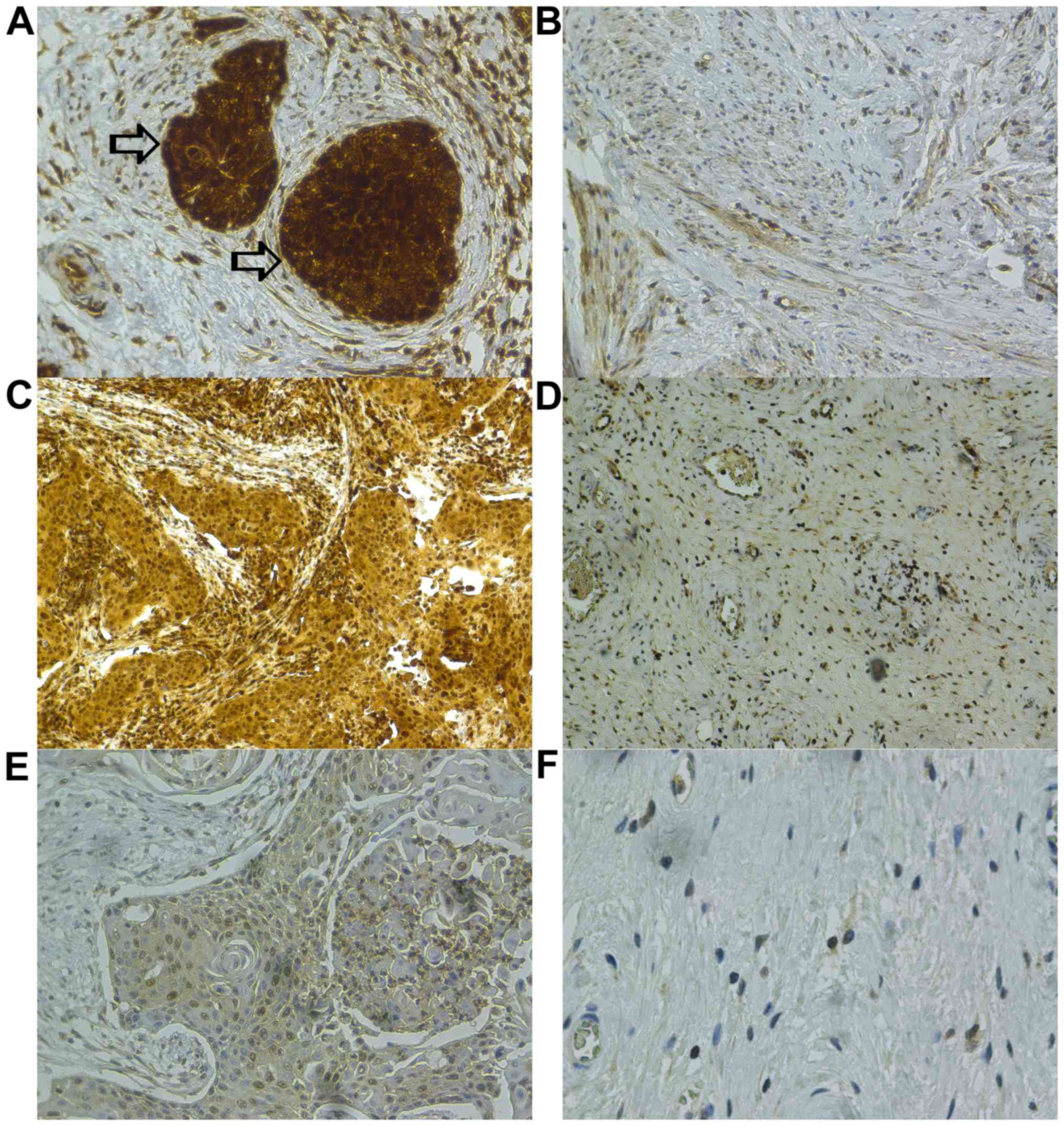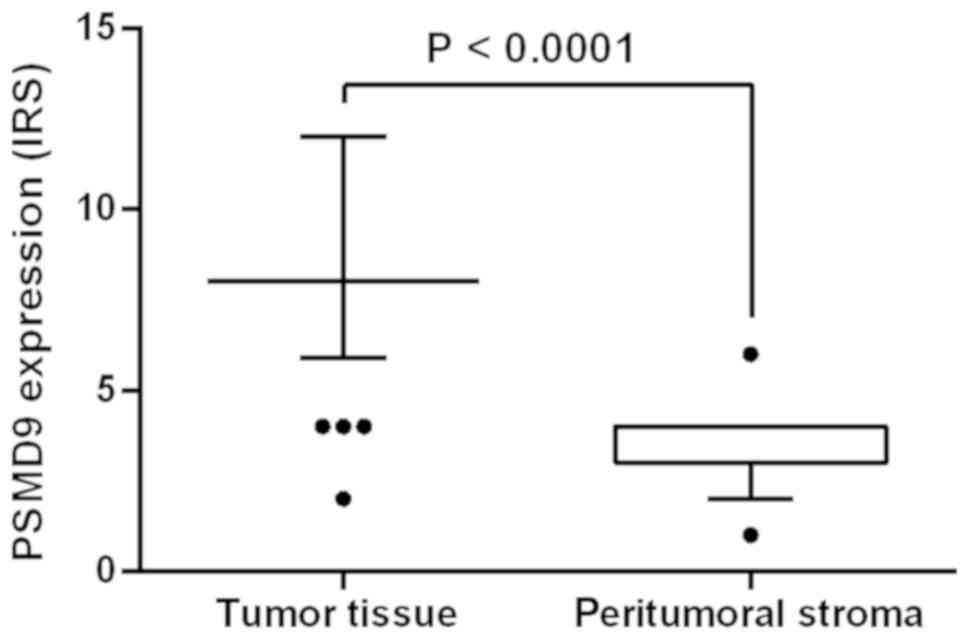|
1
|
World Health Organization: Cervical
cancer. https://www.who.int/cancer/prevention/diagnosis-screening/cervical-cancer/en/2019.
|
|
2
|
zur Hausen H: Papillomaviruses in the
causation of human cancers-a brief historical account. Virology.
384:260–265. 2009. View Article : Google Scholar : PubMed/NCBI
|
|
3
|
Olusola P, Banerjee HN, Philley JV and
Dasgupta S: Human papilloma virus-associated cervical cancer and
health disparities. Cells. 8(pii): E6222019. View Article : Google Scholar : PubMed/NCBI
|
|
4
|
Marth C, Landoni F, Mahner S, McCormack M,
Gonzalez-Martin A and Colombo N; ESMO Guidelines Committee, :
Cervical cancer: ESMO clinical practice guidelines for diagnosis,
treatment and follow-up. Ann Oncol. 28 (Suppl 4):iv72–iv83. 2017.
View Article : Google Scholar
|
|
5
|
Leitlinienprogramm Onkologie (Deutsche
Krebsgesellschaft DK, AWMF), . S3-Leitlinie Diagnostik, Therapie
und Nachsorge der Patientin mit Zervixkarzinom, Langversion, 1.0,
2014, AWMF-Registernummer: 032/033OL. http://leitlinienprogramm-onkologie.de/Leitlinien.7.0.html2014.
|
|
6
|
Cohen PA, Jhingran A, Oaknin A and Denny
L: Cervical cancer. Lancet. 393:169–182. 2019. View Article : Google Scholar : PubMed/NCBI
|
|
7
|
Thomas MK, Tsang SW, Yeung ML, Leung PS
and Yao KM: The roles of the PDZ-containing proteins bridge-1 and
PDZD2 in the regulation of insulin production and pancreatic
beta-cell mass. Curr Protein Pept Sci. 10:30–36. 2009. View Article : Google Scholar : PubMed/NCBI
|
|
8
|
Langlands FE, Dodwell D, Hanby AM, Horgan
K, Millican-Slater RA, Speirs V, Verghese ET, Smith L and Hughes
TA: PSMD9 expression predicts radiotherapy response in breast
cancer. Mol Cancer. 13:732014. View Article : Google Scholar : PubMed/NCBI
|
|
9
|
Banz-Jansen C, Munchow B, Diedrich K and
Finas D: Bridge-1 is expressed in human breast carcinomas:
Silencing of Bridge-1 decreases Smad2, Smad3 and Smad4 expression
in MCF-7 cells, a human breast cancer cell line. Arch Gynecol
Obstet. 284:1543–1549. 2011. View Article : Google Scholar : PubMed/NCBI
|
|
10
|
Banz C, Munchow B and Diedrich K: Bridge-1
is expressed in human granulosa cells and is involved in the
activin A signaling cascade. Fertil Steril. 93:1349–1352. 2010.
View Article : Google Scholar : PubMed/NCBI
|
|
11
|
Hoellen F, Waldmann A, Banz-Jansen C,
Holtrich U, Karn T, Oberländer M, Habermann JK, Hörmann M, Köster
F, Ribbat-Idel J, et al: Claudin-1 expression in cervical cancer.
Mol Clin Oncol. 7:880–884. 2017. View Article : Google Scholar : PubMed/NCBI
|
|
12
|
Hoellen F, Waldmann A, Banz-Jansen C, Rody
A, Heide M, Köster F, Ribbat-Idel J, Thorns C, Gebhard M,
Oberländer M, et al: Expression of cyclooxygenase-2 in cervical
cancer is associated with lymphovascular invasion. Oncol Lett.
12:2351–2356. 2016. View Article : Google Scholar : PubMed/NCBI
|
|
13
|
Oberländer M, Alkemade H, Bünger S, Ernst
F, Thorns C, Braunschweig T and Habermann JK: A ‘waterfall’
transfer-based workflow for improved quality of tissue microarray
construction and processing in breast cancer research. Pathol Oncol
Res. 20:719–726. 2014. View Article : Google Scholar : PubMed/NCBI
|
|
14
|
Remmele W and Stegner HE: Recommendation
for uniform definition of an immunoreactive score (IRS) for
immunohistochemical estrogen receptor detection (ER-ICA) in breast
cancer tissue. Pathologe. 8:138–140. 1987.(In German). PubMed/NCBI
|
|
15
|
Hemmerich W: Rechner zur Adjustierung des
α-Niveaus: StatistikGuru. https://statistikguru.de/rechner/adjustierung-des-alphaniveaus.htmlJuly
21–2019
|
|
16
|
McBride WH, Iwamoto KS, Syljuasen R,
Pervan M and Pajonk F: The role of the ubiquitin/proteasome system
in cellular responses to radiation. Oncogene. 22:5755–5773. 2003.
View Article : Google Scholar : PubMed/NCBI
|
|
17
|
Kisser A and Zechmeister-Koss I: A
systematic review of p16/Ki-67 immuno-testing for triage of low
grade cervical cytology. BJOG. 122:64–70. 2015. View Article : Google Scholar : PubMed/NCBI
|
|
18
|
Yu L, Fei L, Liu X, Pi X, Wang L and Chen
S: Application of p16/Ki-67 dual-staining cytology in cervical
cancers. J Cancer. 10:2654–2660. 2019. View Article : Google Scholar : PubMed/NCBI
|
|
19
|
Sabeena S, Kuriakose S, Damodaran B,
Ravishankar N and Arunkumar G: Human papillomavirus (HPV) DNA
detection in uterine cervix cancer after radiation indicating
recurrence: A systematic review and meta-analysis. J Gynecol Oncol.
31:e202020. View Article : Google Scholar : PubMed/NCBI
|
|
20
|
Badaracco G, Savarese A, Micheli A, Rizzo
C, Paolini F, Carosi M, Cutillo G, Vizza E, Arcangeli G and Venuti
A: Persistence of HPV after radio-chemotherapy in locally advanced
cervical cancer. Oncol Rep. 23:1093–1099. 2010.PubMed/NCBI
|
|
21
|
Song YJ, Kim JY, Lee SK, Lim HS, Lim MC,
Seo SS, Kang S, Lee DO and Park SY: Persistent human papillomavirus
DNA is associated with local recurrence after radiotherapy of
uterine cervical cancer. Int J Cancer. 129:896–902. 2011.
View Article : Google Scholar : PubMed/NCBI
|
|
22
|
Yu MC, Austin RM, Lin J, Beck T, Beriwal
S, Comerci JT, Edwards RP, Sukumvanich P, Kelley J and Olawaiye AB:
The role of high-risk human papilloma virus testing in the
surveillance of cervical cancer after treatment. Archives of
pathology & laboratory medicine. 139:1437–1440. 2015.
View Article : Google Scholar
|
|
23
|
Deng T, Feng Y, Zheng J, Huang Q and Liu
J: Low initial human papillomavirus viral load may indicate worse
prognosis in patients with cervical carcinoma treated with surgery.
J Gynecol Oncol. 26:111–117. 2015. View Article : Google Scholar : PubMed/NCBI
|
|
24
|
Kamer S, Ren Q and Dicker AP: Differential
radiation sensitization of human cervical cancer cell lines by the
proteasome inhibitor velcade (bortezomib, PS-341). Arch Gynecol
Obstet. 279:41–46. 2009. View Article : Google Scholar : PubMed/NCBI
|
|
25
|
Pajonk F, Grumann T and McBride WH: The
proteasome inhibitor MG-132 protects hypoxic SiHa cervical
carcinoma cells after cyclic hypoxia/reoxygenation from ionizing
radiation. Neoplasia. 8:1037–1041. 2006. View Article : Google Scholar : PubMed/NCBI
|
|
26
|
Crawford LJ, Walker B and Irvine AE:
Proteasome inhibitors in cancer therapy. J Cell Commun Signal.
5:101–110. 2011. View Article : Google Scholar : PubMed/NCBI
|
|
27
|
Harish M, Kannan S, Puttagunta S, Pradhan
MR, Verma CS and Venkatraman P: A novel determinant of PSMD9 PDZ
binding guides the evolution of the first generation of super
binding peptides. Biochemistry. 58:3422–3433. 2019. View Article : Google Scholar : PubMed/NCBI
|
|
28
|
Han M, Wang H, Zhang HT and Han Z:
Expression of TIP-1 confers radioresistance of malignant glioma
cells. PLoS One. 7:e454022012. View Article : Google Scholar : PubMed/NCBI
|

















